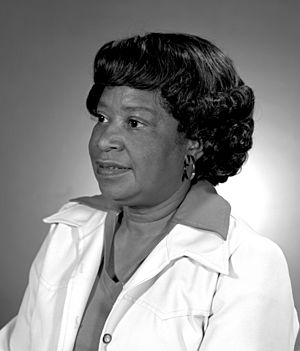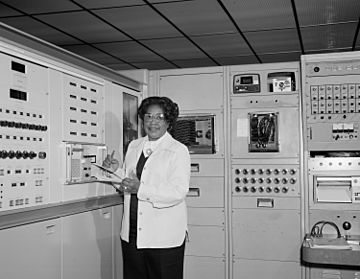Mary Jackson (engineer) facts for kids
Quick facts for kids
Mary Jackson
|
|
|---|---|

Mary Jackson in 1979
|
|
| Born |
Mary Winston
April 9, 1921 |
| Died | February 11, 2005 (aged 83) Hampton, Virginia, US
|
| Resting place | Bethel AME Church Cemetery, Hampton, Virginia |
| Alma mater | Hampton Institute |
| Spouse(s) |
Levi Jackson, Sr.
(m. 1944) |
| Children | 2 |
| Scientific career | |
| Fields | Aerospace engineering, mathematics |
| Institutions | NASA |
Mary Jackson (born Mary Winston, April 9, 1921 – February 11, 2005) was an amazing American mathematician and aerospace engineer. She worked for the National Advisory Committee for Aeronautics (NACA), which later became NASA in 1958. She spent most of her career at the Langley Research Center in Hampton, Virginia.
Mary started her career in 1951 as a "computer" in a special group called the West Area Computing division. This group was segregated, meaning black and white workers were kept separate. She took advanced engineering classes and, in 1958, made history by becoming NASA's first black female engineer.
After working for 34 years at NASA, Mary reached the highest engineering title possible. She then decided to take a different path. She became a manager in programs that helped women and minorities. In this new role, she worked hard to make sure women had fair chances to be hired and promoted in science, engineering, and math jobs at NASA.
Mary Jackson's inspiring story is featured in the 2016 book Hidden Figures. She is also one of the main characters in the movie Hidden Figures, which came out the same year. In 2019, she was given the Congressional Gold Medal after her death. In 2021, NASA's headquarters in Washington, D.C., was renamed the Mary W. Jackson NASA Headquarters in her honor.
Her Early Life and Family
Mary Winston was born on April 9, 1921, in Hampton, Virginia. Her parents were Ella and Frank Winston. She grew up in Hampton and graduated with top honors from the all-black George P. Phenix Training School.
In 1942, Mary earned her college degrees in mathematics and physical science from Hampton University. She was also a member of the Alpha Kappa Alpha sorority.
Mary was a dedicated Girl Scout leader for over 30 years. In the 1970s, she was known for helping African American children in her community build a small wind tunnel. This allowed them to test airplane models, sparking their interest in science.
On November 18, 1944, Mary married Levi Jackson, Sr., who was a sailor in the U.S. Navy. They had two children, Levi Jackson, Jr. and Carolyn Marie Lewis. Mary Jackson passed away on February 11, 2005, at the age of 83.
Her Career at NASA

After college, Mary Jackson taught math for a year at a school for African-American students in Maryland. At that time, schools in the South were still separated by race. She also tutored high school and college students, which she continued to do throughout her life.
In 1951, Mary was hired by the National Advisory Committee for Aeronautics (NACA). This agency later became NASA. She started as a research mathematician, often called a "computer," at the Langley Research Center in Hampton, Virginia. She worked under Dorothy Vaughan in the segregated West Area Computing Section.
In 1953, Mary began working for engineer Kazimierz Czarnecki. They worked in the Supersonic Pressure Tunnel. This huge wind tunnel was 4 by 4 foot (1.2 by 1.2 m) and used 60,000 horsepower. It created winds almost twice the speed of sound to study forces on model airplanes.
Czarnecki encouraged Mary to train to become an engineer. To do this, she needed to take advanced math and physics classes. These classes were offered at night by the University of Virginia, but they were held at the all-white Hampton High School. Mary had to ask the City of Hampton for special permission to attend these classes.
After finishing her courses, Mary was promoted to aerospace engineer in 1958. This made her NASA's first black female engineer. She studied data from wind tunnel tests and real airplane flights. Her goal was to understand how air flows around planes, including thrust (the pushing force) and drag (the pulling force). This research helped improve American airplanes.
Mary worked as an engineer in several different NASA divisions. She wrote or helped write 12 technical papers for NACA and NASA. She also worked to help women and other minorities get ahead in their careers. She advised them on what to study to qualify for promotions.
By 1979, Mary Jackson had reached the highest engineering title. She then decided to take a lower-level job to become an administrator in the Equal Opportunity field. After training, she returned to Langley. She worked to make changes and highlight the achievements of women and other minorities in science. She managed programs that helped women and minorities get jobs and promotions in science, engineering, and math at NASA. She continued working at NASA until she retired in 1985.
Her Lasting Impact
The 2016 movie Hidden Figures tells the story of Mary Jackson, Katherine Johnson, and Dorothy Vaughan. It shows their important work at NASA during the Space Race, especially on Project Mercury. The movie is based on a book by Margot Lee Shetterly. In the film, Mary Jackson is played by actress Janelle Monáe.
In 2018, a school in Salt Lake City, Utah, was renamed Mary Jackson Elementary School. It used to be named after President Andrew Jackson.
On February 26, 2021, NASA's main building in Washington, D.C., was officially renamed the Mary W. Jackson NASA Headquarters. This was a great honor for her contributions.
Awards and Honors
- Apollo Group Achievement Award, 1969
- Daniels Alumni Award for Outstanding Service to Disadvantaged Youth
- National Council of Negro Women, Inc. Certificate of Recognition for Outstanding Service to the Community
- Distinguished Service Award for her work with the Combined Federal Campaign, 1972
- Langley Research Center Outstanding Volunteer Award, 1975
- Langley Research Center Volunteer of the Year, 1976
- Iota Lambda Sorority Award for the Peninsula Outstanding Woman Scientist, 1976
- King Street Community Center Outstanding Award
- National Technical Association's Tribute Award, 1976
- Hampton Roads Chapter "Book of Golden Deeds" for service
- Langley Research Center Certificate of Appreciation, 1976–1977
- Congressional Gold Medal, 2019
See also
 In Spanish: Mary Jackson (ingeniera) para niños
In Spanish: Mary Jackson (ingeniera) para niños




